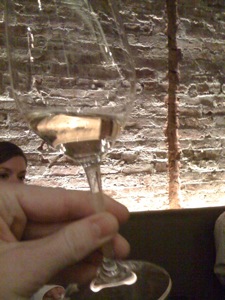One Fizzy Evening
“One holds a bottle of red wine by the neck, a woman by the waist, and a bottle of Champagne by the derrière.” —Mark Twain
My partner, Adam, and I had accumulated four bottles of Champagne in recent years, always receiving it as a gift. While we like it well enough, we can’t help but think of it as a special-occasion beverage—and we tend to celebrate special occasions in restaurants. About a month ago, fed up with our refrigerator being overtaken by Champagne, Adam announced that the two of us would be having a “Champagne party,” and he made little toasts topped with smoked salmon and crème fraiche, a pasta with butter and truffle salt (it had been languishing in the pantry), a rich cheese, and strawberries. It was a hoot, and we congratulated ourselves on lowering our Champagne inventory by a full 25 percent. Two weeks later, some friends gave me a bottle of Veuve Clicquot’s La Grande Dame for my birthday; the fancy lacquered box it comes in looks like it might contain a deceased industrialist’s ashes—and it takes up even more space in the fridge.
So when Keri Kunzle of Maslow 6 invited me to attend one of the store’s autumn seminars, I couldn’t resist the class devoted to Champagne. If I’m going to be cursed by always having Champagne around (that was a joke), I might as well get to know it better.
 Tuesday evening, I joined Keri and eight others at Vino Vino, the wine bar adjacent to Maslow 6, while Maslow’s wine director Mollie Battenhouse–herself a sparkler—taught us all about how Champagne is bottled and aged. We sampled eight, which for me was revelatory: Tasting the wines side by side really showed off their differences. It’s perhaps no surprise that the Krug Grande Cuvee ($138) was the group favorite, though I went back for more of the Vilmart & Cie Cuvee Creation 1999 ($125), which had the complexity I’m drawn to in a red wine and a hint of the ripeness I love in cheese. I had no idea Champagne could be that interesting.
Tuesday evening, I joined Keri and eight others at Vino Vino, the wine bar adjacent to Maslow 6, while Maslow’s wine director Mollie Battenhouse–herself a sparkler—taught us all about how Champagne is bottled and aged. We sampled eight, which for me was revelatory: Tasting the wines side by side really showed off their differences. It’s perhaps no surprise that the Krug Grande Cuvee ($138) was the group favorite, though I went back for more of the Vilmart & Cie Cuvee Creation 1999 ($125), which had the complexity I’m drawn to in a red wine and a hint of the ripeness I love in cheese. I had no idea Champagne could be that interesting.
Not only was the seminar highly enjoyable, but I now know quite a bit about Champagne. Here’s but a flute’s worth of what I learned:
• The first writer to refer to Champagne as we know it was English, in 1676. In fact, the English were the ones who came up with a bottle strong enough to contain Champagne.
• Dom Perignon accomplished much in regard to wine, but nowhere in his extensive, meticulous notes did he mention anything about making sparkling wine.
• Champagne is primarily made from three grapes: Pinot Noir, Pinot Meunier, and Chardonnay. A blanc de blanc is made exclusively from white grapes (which is to say, Chardonnay).
• Many bottlers use crown caps—like the ones on a bottle of Bud—during the aging process.
• The French look down a little at rosé Champagne—although we agreed that the one we tasted, Vilmart & Cie Cuvee Rubis Premier Cru Rosé ($80), was delicious.
• The letters “NM” on a label stand for “négociant-manipulant,” indicating that the grapes were purchased from a vineyard not owned by the winemaker. “RM” indicates “récoltant manipulant” (the grower also makes the Champagne).
• The colder you store Champagne, the finer the bubble.
• The pressure in a bottle of Champagne is equivalent to six atmospheres. A diver in the group said that that’s what you’d feel if you were 200 feet below the sea.
• When you’re opening a bottle of Champagne, you shouldn’t remove the wire cage—if only because you never want to take your hand off the cork, lest it fly out and kill someone. (On the other hand, what a way to go!) And turning the bottle instead of the cork gives you greater control as you ease the cork out.
• The goal is a hiss, not a pop.
Maslow 6 holds seminars throughout the year, some led by Mollie (who is an Advanced Sommelier and holds a WSET diploma), others by winemakers from around the world. They tend to cost $100. 211 West Broadway (bet. White and Franklin), 212-226-3127, maslow6.com.
P.S. I took a few wonderful photos that my computer devoured. It was a much more attractive evening that this photo would indicate!


















